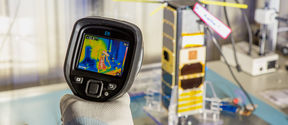Scientists have designed an ultra-miniaturized spectrometer that could directly make chemical fingerprint analysis. Made from a single nanowire, the spectrometer is the smallest ever designed. It could be used in potential applications such as assessing the freshness of foods, the quality of drugs, identifying counterfeit objects, or even imaging single cells, all possible from within a smartphone camera. Details are reported in the journal Science.
In the 17th century, Sir Isaac Newton, through his observations on the splitting of light by a prism, sowed the seeds for a whole new field of science studying the interactions between light and matter – spectroscopy. Today, optical spectrometers are essential tools in the industry and almost all fields of scientific research. Through analysing the characteristics of light, they can tell us about the processes within galactic nebulae, millions of lightyears away, down to the characteristics of protein molecules.
However, even now, the majority of spectrometers are based around principles similar to what Newton demonstrated with his prism: the spatial separation of light into different spectral components. Such a basis fundamentally limits these spectrometers in respect of miniaturisation; they are usually bulky and complex, and certainly challenging to shrink to sizes much smaller than a coin. Four hundred years after Newton, collaborative research between Finland, UK and China has overcome this challenge to produce a system up to a thousand times smaller than those previously reported.
The researchers used a nanowire whose material composition is varied along its length, enabling it to be responsive to different colours of light across the visible spectrum. Using techniques similar to those used for the manufacture of computer chips, they then created a series of light-responsive sections on this nanowire.
“The nanowire structure we use is very unique having gradually changed bandgap. It allows efficient distinguishing of light at different colours”, said Prof. Zhipei Sun from Aalto University.
“We engineered the nanowire that allows us to get rid of the dispersive elements, like a prism, producing a far simpler, ultra-miniaturised system than conventional spectrometers can allow” said first author Zongyin Yang from the Cambridge Graphene Centre. “The individual responses we get from the nanowire sections can then be directly fed into a computer algorithm to reconstruct the incident light spectrum.”
“Our approach could allow unprecedented miniaturisation of spectroscopic devices, to an extent that could see them incorporated directly into smartphones, bringing powerful analytical technologies from the lab to the palm of our hands,” said Tawfique Hasan, who led the study.
One of the most promising potential uses of the nanowire could be in biology. Since the device is so tiny, it can directly image single cells without the need for a microscope. And unlike other bioimaging techniques, the information obtained by the nanowire spectrometer contains a detailed analysis of the chemical fingerprint of each pixel. Prof. Sun expects that such new nanowire devices with record-breaking footprint and broad spectral response could be utilized for a wide range of academic and industrial applications, e.g., biological implants, and smart wearable devices.
Aalto University studies fabrication and properties of nanowire structures and develops new applications for photonics and quantum technologies.
Reference:
Zongyin Yang et al. ‘Single nanowire spectrometers.’ Science (2019). DOI: 10.1126/science.aax8814












